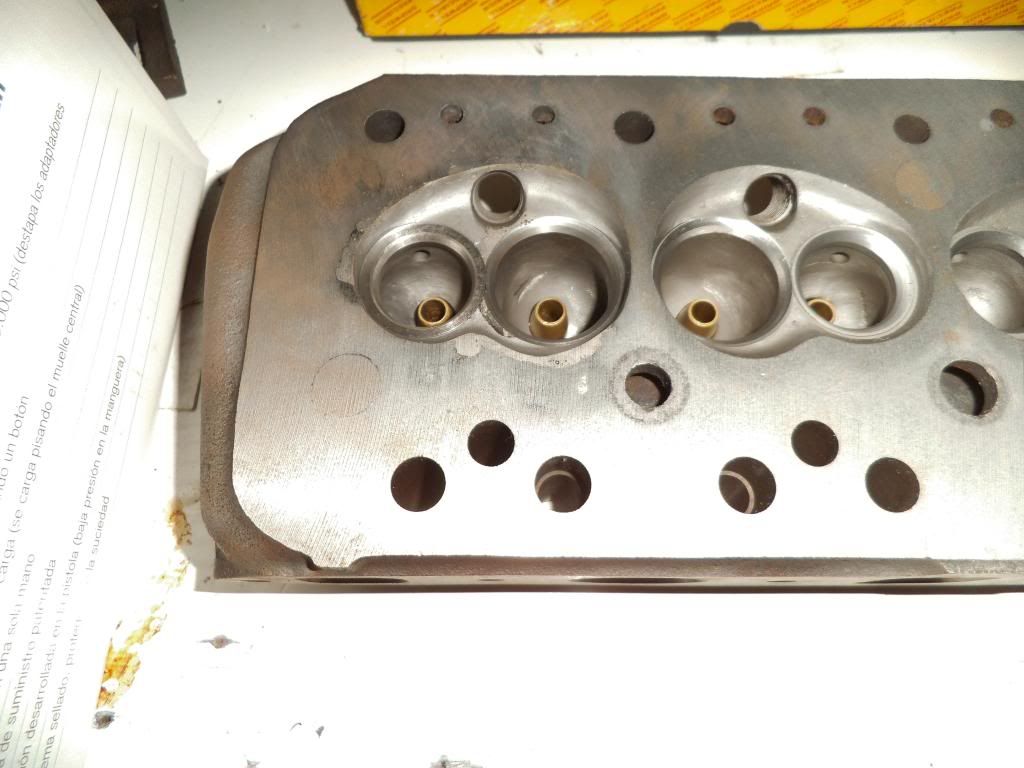My 12g940b head (std) has just had a maintenance skim and the machinist mentioned a small hairline crack off one off the waterways. He's not experienced with such an 'old' engine so I thought I'd ask the oracles on here. I've not seen it myself yet but it is not around the valves but on the head face around one of the waterways. Thoughts anyone?

Waterway Hairline Crack
#1

Posted 26 February 2015 - 11:49 AM
#2

Posted 26 February 2015 - 12:37 PM
While repairing cracks in heads is possible... I cannot comment on whether it is financially prudent vs the cost of a replacement head. However, I can comment that any crack that is present and left un-addressed is likely to get worse and eventually lead to problems.
#3

Posted 26 February 2015 - 08:18 PM
I agree with Doug that any crack in a head is not going to get better.
However it would be worth finding out exactly where this crack is on the head - take a few pictures and post up on the forum. May still be OK to use.
Chances are that the crack has been there quite a while - unless you have had the head skimmed because the engine overheated badly and blew the head gasket?
#4

Posted 26 February 2015 - 08:43 PM
Stripped the engine because of compression ring failure. Had +.20 bore plus head and block clean up skim. Headgasket was intact and no sign of overheating.
I'll be taking new pistons to the engineer next week so I'll take some photos. Thanks
#5

Posted 26 February 2015 - 09:31 PM
Castings like Heads and Blocks if they are going to develop cracks will usually do so from a place in the casting that is stressed as a result of being cast in the first place and not being stress relieved after casting, it's not to necessarily say it's a flaw per se but a weak point. Sometimes these show up after a few heat cycles and sometimes they never show up.
So, when something like a head develops cracks and it hasn't been caused by overheating or the like, there's a reasonable chance that the crack will grow to a point and then stop. Just where that point is is anyone's guess, never know, it could we have reached that point already or it may yet be getting there.
Maybe not much more than a head gasket to loose by fitting it and seeing how you go with it, not the end of the world if it gives trouble, easily swapped out at a later time.
It is because of residule stress that can be left in castings that makes welding repair less desirable by comercial shops, it can definitely be done successfully, but does need to be done the right way. The other method that does work, though I'm not crazy about it, is to stitch the cracks with cast iron threaded plugs.
Here one that we did here a few years back, though not in to a waterway
#6

Posted 27 February 2015 - 08:43 PM
Thanks Moke Spider for another perspective. Your info is appreciated. It is much like subsidence cracks in houses. They can be ongoing due to underground movement or historical cracks due to long ago settlement. Easy to test for with a house, engineers araldite a piece of glass across the crack and come back months later to see if the glass had cracked/snapped.
In my case the engine has done a lot of miles and is/was basically worn out but the headgasket was intact and no indication of either water in oil or oil in water. Exhaust was clear as well. Fingers crossed....I'll still take some photos next week though.
#7

Posted 03 March 2015 - 04:38 PM
Just picked up my block, crank and head from engineers. Here's a piccie of the hairline crack.
Do I ignore it and pretend it's not there?
Attached Files
#8

Posted 03 March 2015 - 08:10 PM
That looks terminal to me I'm afraid.
#9

Posted 03 March 2015 - 08:14 PM
#10

Posted 03 March 2015 - 08:20 PM
#11

Posted 03 March 2015 - 08:55 PM
Had a crack like this on another engine type, it was a diesel. roughly similar configuration, lets just say I cursed not replacing the head.
Is that between chamber 2 &3 the middle of the head?
#12

Posted 03 March 2015 - 08:59 PM
Well - and just my opinion based on the photo - I have good news and bad news
The Good News - I'd be quite certain that the crack has stabilised and won't grow any further
The Bad News - IMO, the head either needs welding or scrapping. Sorry, but now I see it, I wouldn't bother fitting it.
From your initial post, somehow I got an impression that there was one or two small cracks say 3 - 4 mm long emanating from one of the deck holes, but now I see that it runs across the deck between two holes,,,,, well,,,,,,
Because it has gone in the centre like that and from hole to hole, I really doubt the crack was in the casting, but the casting I'd say was stressed and has 'surfaced' since the original casting and machining period from a few normal heat cycles.
#13

Posted 03 March 2015 - 09:16 PM
Interesting replies covering quite a range of differing views. It is between number 2 and 3 cylinders and wasn't visible until the head was skimmed. The head skim was very minor, just basically a cleanup as the picture shows so I don't think there has been any problem with this crack up to now.
I had intended to fit larger inlets to this head and also do some porting and chamber cleanup but I think not now. If I can't source another head I think I'll just put this one back on and make sure my breakdown cover is up to date.
I'd welcome more opinions though, especially from anyone that has seen cracks like this before.
Anyone with a 12g940 A+ head for sale, bare or complete?
Edited by whistler, 03 March 2015 - 09:17 PM.
#14

Posted 04 March 2015 - 04:14 PM
12G940 head castings are so cheap the best attitude is 'if it's cracked it's scrapped'.
Try to find one with 35.6/29.5 mm valves.
#15

Posted 04 March 2015 - 05:46 PM
12G940 head castings are so cheap the best attitude is 'if it's cracked it's scrapped'.
Try to find one with 35.6/29.5 mm valves.
Thanks Cooperman, I'm looking, I'm looking..... already bought the 35.7mm inlet valves so they might be up for sale if I can find a big valve head.
1 user(s) are reading this topic
0 members, 1 guests, 0 anonymous users



















